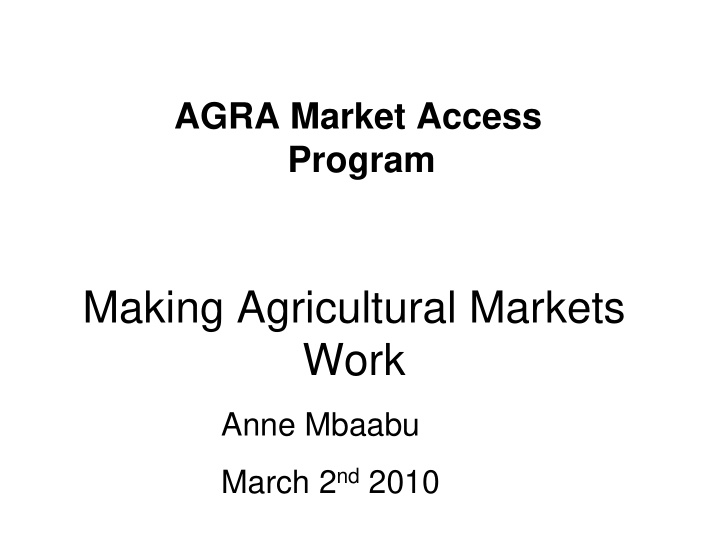



AGRA Market Access Program Making Agricultural Markets Work Anne Mbaabu March 2 nd 2010
Importance of Staple Foods • Cereals contribute 51 percent of Africa’s calorie supply • The main cereals in SSA region comprise maize, rice, wheat, beans, and sorghum, millet • Maize is the most important individual food commodity, accounting for 15 percent of caloric intake, followed by cassava (12 percent), rice (9 percent), and sorghum/millet (8 percent). • Maize is dominant in production and consumption. In East & S.african region, maize is associated with food security: – “Where there’s no maize there is NO food.” – “Where there’s no food there is NO peace” hence maize has become a political crop • Rice and wheat are the most heavily imported crops • Wheat consumption is growing at a faster rate than maize
State of play in the Cereal sector... • Governments still play a major role including price setting, levies, duties and import/export ban, fixed producer price, etc • Reduced investments in R&D and on production • Marketing is still a challenge due to poor farm to market linkage infrastructure
State of play in the Cereal sector... • Low market transparency due to inadequate market information systems and grades and standards • Limited use of rules of trade due to frail legal environments that lead to weak institutions governing property rights and contract enforcement • Sector getting organized but systems not fully operational
Poverty relevance • Over 85% of Staple foods are grown by small scale farmers • Poor agronomical knowledge leads to low productivity • Due to lack of money, most farmers do not use certified seed and fertilizer leading to poor productivity hence reduced incomes • Many farmers do not produce enough cereals to generate a marketable surplus • Liquidity constraints mean that farmers must meet their cash needs by selling their produce at harvest-time rather than wait until later in the season for better prices • Farmers are net cereals buyers
High food prices have triggered protectionism policy • Percentage of disposable income spent on food; – USA 7.2% – Canada 9% – India 33%, – Africa 75%
State of play in the Cereal sector… • Problems facing the regional food markets have been known for over 50 years; they include: 1. High transport costs for both goods and people � Poor infrastructure � Transport costs account for the bulk of all food marketing costs in Africa, reaching as high as 54% in Ethiopia’s and 37% for Malawi’s grain markets (2003 study) 2. Inadequate storage facilities � High post harvest losses (high cost) � harvest processes are underdeveloped because of lack of knowledge about proper drying practices and appropriate grading systems. � growth of mycotoxins (aflatoxin)
State of play in the Cereal sector… 3. Lack of market information � traders lack information about the timing, quantity, and location marketable surpluses of grains 5. Limited value addition and lack of non- food uses of food commodities 6. Unpredictable policy environment Export ban;-Ke, Tz, . Trading ban; Malawi 7. Low productivity – Yield per hectare
Trade policies • Trade policies directly affect the prices and quantities of agricultural commodities produced, exported, imported, as well as, inputs applied. • Such policies normally have domestic, sub-regional, regional and international trade effects.
Markets: cross-border trade • Unstructured, but very important • Volume flowing across the border can determine government actions
• Current state of the market • No Grade and Standards • Reduced income to farmers • Lack of storage in market places • Uneconomical volumes
Trade flow routes • Improve commercial food flow from surplus to deficit areas • Improve trade flows at national and regional level • Reduce barriers to local and regional trade
mb Food & trade mb flow without borders mb mb mb mb
AGRA interventions along the value chain Seeds Program Investments for the Green Market Access Market Access Policy & advocacy, M&E Soil Health Revolution Agricultural Extension Water Resources l l l l l l l l 2007 2008 2009 2010 2011 2012 2013 2014
AGRA interventions along the value chain • Program for Africa Seed System; – Training of breeders, seed production, – Agro-dealer program – access to inputs • Soil Health Program – Soil analysis, access to Ferts, organic manure – Smart Subsidies • Policy and Partnership – Trade policy development and access to credit • First loss guarantee • Market Access Program • Agricultural Extension and Water (in the pipeline)
Market access for farmers Adequate storage to reduces postharvest losses Accurate AGRA Increased market information interventions production Awareness of grades and standards Value addition and promotion of non ‐ food usage
Investments aimed at: • Reducing transaction costs – Improve on ‐ farm storage technologies – Improve rural market places – Improve market information systems • Increasing value addition in food usage – quality grading standards; – promote low ‐ cost small and medium scale processing facilities; – Encourage and promote convenience and easy to prepare foods; – low ‐ cost on ‐ farm testing equipments . • Increasing demand through alternative uses – expand livestock feed industries – Expand industrial usages • Promoting an enabling environment
Confidential AGRA MARKETS APPROACH … Direct Procurement Market Development Storage & Services Direct Procurement Market Development Storage & Services Enabling smallholder farmers Creating an enabling Addressing a key systemic to leverage structured demand environment for agricultural barrier commercialization to take place Each archetype addresses one or more Market Access strategic objectives: Each archetype addresses one or more Market Access strategic objectives: Reduce transaction cost/ Increase value addition in food usage/ Increase demand via alternative Reduce transaction cost/ Increase value addition in food usage/ Increase demand via alternative uses/ Promote an enabling environment uses/ Promote an enabling environment
Goals • Ultimate goal is to improve commercial food flow from surplus to deficit areas • Improve trade flows at national and regional level, resulting in market price stabilization, better incomes for the farmers and increased food security
Thank You
Recommend
More recommend